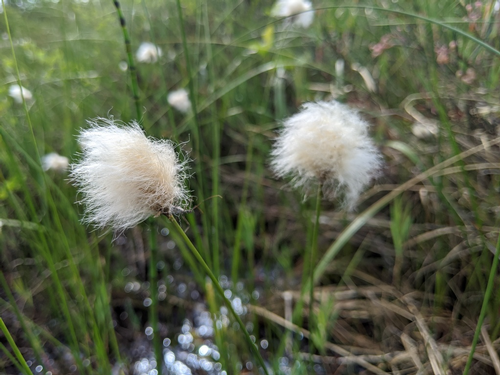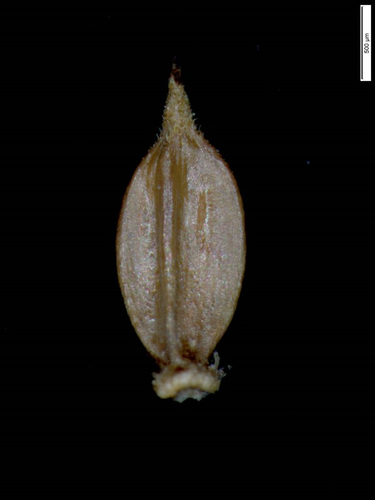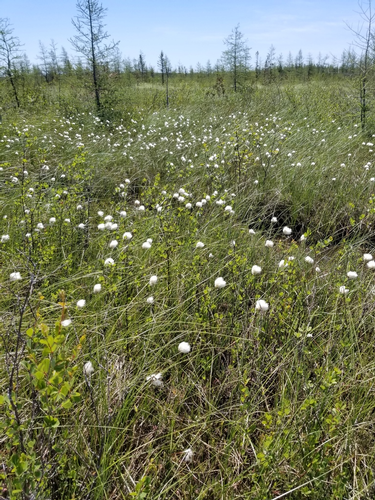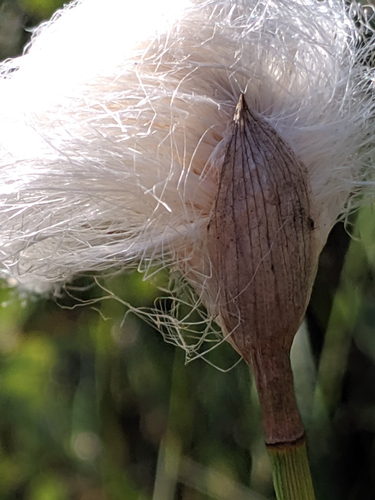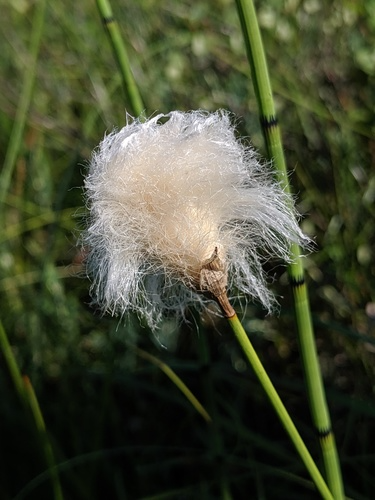Plants and Animals
Eriophorum russeolum Russet cotton-grass
Key Characteristics
Rhizomatous sedge that is 9-70 cm tall and forms sizeable clonal colonies. Leaves are sparse and commonly basal, but often there are a few brown, paper-like cauline leaves that form sheaths. Stem cross-section is terete and can be up to 1.5 mm in diameter. The inflorescence is one ovoid head with multiple florets, which distinguishes it from most other Michigan cottongrasses which have multiple heads. The florets have multiple off-white perianth bristles and are subtended by a single scale. The fruit are obovoid or ellipsoid and brown achenes that have a triangular cross-section and a short beak at the tip.
Status and Rank
US Status: No Status/Not Listed
State Status: T - Threatened (legally protected)
Global Rank: G5 - Secure
State Rank: SNR - Not ranked
Occurrences
| County | Number of Occurrences | Year Last Observed |
|---|
Information is summarized from MNFI's database of rare species and community occurrences. Data may not reflect true distribution since much of the state has not been thoroughly surveyed.
Habitat
There are only two known occurrences in Michigan, both in poor fens within fen-conifer swamp complexes.
Natural Community Types
For each species, lists of natural communities were derived from review of the nearly 6,500 element occurrences in the MNFI database, in addition to herbarium label data for some taxa. In most cases, at least one specimen record exists for each listed natural community. For certain taxa, especially poorly collected or extirpated species of prairie and savanna habitats, natural community lists were derived from inferences from collection sites and habitat preferences in immediately adjacent states (particularly Indiana and Illinois). Natural communities are not listed for those species documented only from altered or ruderal habitats in Michigan, especially for taxa that occur in a variety of habitats outside of the state.
Natural communities are not listed in order of frequency of occurrence, but are rather derived from the full set of natural communities, organized by Ecological Group. In many cases, the general habitat descriptions should provide greater clarity and direction to the surveyor. In future versions of the Rare Species Explorer, we hope to incorporate natural community fidelity ranks for each taxon.
Associated Plants
Speckled alder (Alnus incana), dragon’s mouth orchid (Arethusa bulbosa), chokeberry (Aronia prunifolia), bog birch (Betula pumila), creeping sedge (Carex chordorrhiza), coastal sedge (Carex exilis), inland sedge (Carex interior), wiregrass sedge (Carex lasiopcarpa), livid sedge (Carex livida), leatherleaf (Chamaedaphne calyculata), shrubby cinquefoil (Dasiphora fruticosa), water horsetail (Equisetum fluviatile), rattlesnake grass (Glyceria canadensis), wild blue flag (Iris versicolor), bog-laurel (Kalmia polifolia), tamarack (Larix laricina), bogbean (Menyanthes trifoliata), bog aster (Oclemena nemoralis), pitcher-plant (Sarracenia purpurea), white-cedar (Thuja occidentalis), and other cottongrass species
Management Recommendations
A status survey for this species is warranted in fen, conifer swamp, and bog complexes in the Upper Peninsula to better understand its full extent. This species requires nutrient poor wetlands. Natural hydrologic regimes should be maintained. Maintain healthy habitat and minimize fragmentation. Control invasive species and limit use of herbcides, and if used, minimize potential non-target effects.
Survey Methods
Random meander search covers areas that appear likely to have rare taxa, based on habitat and the judgment of the investigator.
-
Meander Search
-
Survey Period: From first week of June to second week of August
-
References
Survey References
- Elzinga, C.L., D.W. Salzer, and J.W. Willoughby. 1998. Measuring and Monitoring Plant Populations. The Nature Conservancy and Bureau of Land Management, Denver. BLM Technical Reference 1730-1. 477pp.
- Goff, G.F., G.A. Dawson, and J.J. Rochow. 1982. Site examination for Threatened and Endangered plant species. Environmental Management 6(4): 307-316
- Nelson, J.R. 1984. Rare Plant Field Survey Guidelines. In: J.P. Smith and R. York. Inventory of rare and endangered vascular plants of California. 3rd Ed. California Native Plant Society, Berkeley. 174pp.
- Nelson, J.R. 1986. Rare Plant Surveys: Techniques For Impact Assessment. Natural Areas Journal 5(3):18-30.
- Nelson, J.R. 1987. Rare Plant Surveys: Techniques for Impact Assessment. In: Conservation and management of rare and endangered plants. Ed. T.S. Elias. California Native Plant Society, Sacramento. 8pp.
Technical References
- Aikan, S.G., M.J. Dallwitz, L.L. Consaul, C.L. McJannet, R.L. Boles, G.W. Argus, J.M. Gillett, P.J. Scott, R. Elven, M.C. LeBlanc, L.J. Gillespie, A.K. Brysting, H. Solstad, and J.G. Harris. 2011. Flora of the Canadian Arctic Archipelago. Eriophorum russeolum Fr. ex Hartm. subsp. leiocarpum Novoselova. <https://nature.ca/aaflora/data/www/cyerch.htm>. Accessed 9 September, 2025.
- Ball, P.W. and D.E. Wujek. 2020. Eriophorum. Flora of North America. <https://floranorthamerica.org/Eriophorum>. Accessed 29 September 2025.
- Cayouette, J. 2004. A Taxonomic Review of the Eriophorum russeolum – E. scheuchzeri Complex (Cyperaceae) in North America. Contributions to Botany 21(2): 791-814.
- Cohen, J.G., and M.A. Kost. 2010. Natural community abstract for poor fen. Michigan Natural Features Inventory, Lansing, MI. Original 2008, updated 2010.
- Consortium of Midwest Herbaria (COMH). 2025. Biodiversity occurrence data published by:?Illinois Natural History Survey, University of Minnesota Herbarium, The Morton Arboretum Herbarium – Vascular Plants, Wisconsin State Herbarium – Vascular Plants, and Chadron State College, High Plains Herbarium. Accessed through Midwest Herbaria Portal Data Portal. <https://midwestherbaria.org/portal/index.php>. Accessed 22 September, 2025.
- Lye, K.A. 2016. Pericarp Diversity in Cyperaceae tribe Scirpeae. Flora 223: 147-158.
- NatureServe. 2023. NatureServe Network Biodiversity Location Data accessed through NatureServe Explorer Web. <https://explorer.natureserve.org/>. Accessed 3 March, 2025.
- Reznicek, A. A., E. G. Voss, and B. S. Walters. 2011. Michigan Flora Online. University of Michigan. Web. <https://michiganflora.net/>. Accessed 31 March 2025.
- Routledge, R., A. Graeff, and J. Marr. 2020. The Discovery of Eriophorum russeolum Fr. subsp. leiocarpum Novoselova (Cyperaceae), White-Bristled Russet Cottongrass, in Michigan. The Great Lakes Botanist 59: 234-238.
- Stevens, P. F. 2017. Angiosperm Phylogeny Website, Version 14. <www.mobot.org/mobot/research/apweb/>. Accessed 31 March 2025.
- Tucker, G.C. and N.G. Miller. 1990. Achene Microstructure in Eriophorum (Cyperaceae): Taxonomic Implications and Paleobotanical Applications. Bulletin of the Torrey Botanical Club 117(3): 266-283.
- Wisconsin Department of Natural Resources (WDNR). 2025. Wisconsin’s rare plants. Cotton-grass (Eriophorum russeolum ssp. leiocarpum). <https://apps.dnr.wi.gov/biodiversity/Home/detail/plants/11761>. Accessed 31 March 2025.


